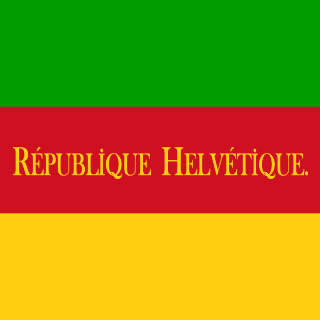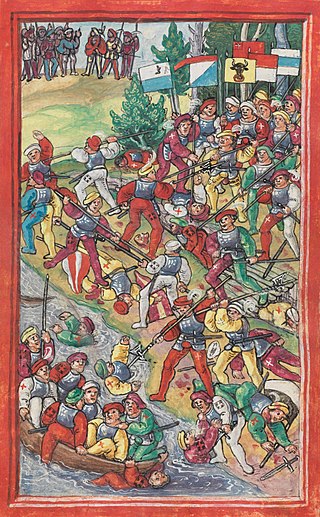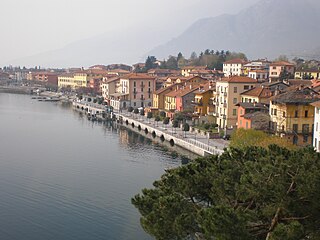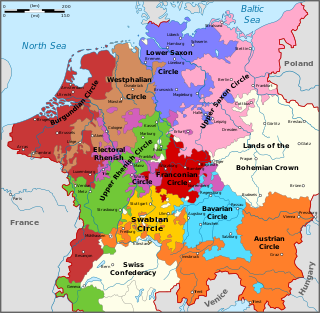
The League of God's House was formed in what is now Switzerland on 29 January 1367, to resist the rising power of the Bishopric of Chur and the House of Habsburg. The League allied with the Grey League and the League of the Ten Jurisdictions in 1471 to form the Three Leagues. The League of God's House, together with the two other Leagues, was allied with the Old Swiss Confederacy throughout the 15th and 16th centuries. After the Napoleonic wars the League of God's House became a part of the Swiss canton of Graubünden.

The Cisalpine Republic was a sister republic of France in Northern Italy that existed from 1797 to 1799, with a second version until 1802.

The Helvetic Republic was a sister republic of France that existed between 1798 and 1803, during the French Revolutionary Wars. It was created following the French invasion and the consequent dissolution of the Old Swiss Confederacy, marking the end of the ancien régime in Switzerland. Throughout its existence, the republic incorporated most of the territory of modern Switzerland, excluding the cantons of Geneva and Neuchâtel and the old Prince-Bishopric of Basel.

The Duchy of Milan was a state in Northern Italy, created in 1395 by Gian Galeazzo Visconti, then the lord of Milan, and a member of the important Visconti family, which had been ruling the city since 1277.

Bellagio is a comune (municipality) in the Province of Como in the Italian region of Lombardy. It is located on Lake Como, also known by its Latin-derived name Lario, whose arms form an inverted Y. The triangular land mass at the base of the inverted Y is the Larian Triangle: at its northern point sits Bellagio, looking across to the northern arm of the lake and, behind it, the Alps. It has always been famous for its location. It belongs to a mountain community named Comunità montana del Triangolo lariano, based in Canzo.

Bellinzona is a municipality, a historic Swiss town, and the capital of the canton of Ticino in Switzerland. The town is famous for its three castles that have been UNESCO World Heritage Sites since 2000.

The Old Swiss Confederacy began as a late medieval alliance between the communities of the valleys in the Central Alps, at the time part of the Holy Roman Empire, to facilitate the management of common interests such as free trade and to ensure the peace along the important trade routes through the mountains. The Hohenstaufen emperors had granted these valleys reichsfrei status in the early 13th century. As reichsfrei regions, the cantons of Uri, Schwyz, and Unterwalden were under the direct authority of the emperor without any intermediate liege lords and thus were largely autonomous.
The Musso War was an armed conflict between the federation of the Three Leagues, which functioned as an associate state of the Old Swiss Confederacy, and the Duchy of Milan early in the 16th century. The conflict took place in two phases, the First Musso War (1524–26) and the Second Musso War (1531–32).

The Swabian War of 1499 was the last major armed conflict between the Old Swiss Confederacy and the House of Habsburg. What had begun as a local conflict over the control of the Val Müstair and the Umbrail Pass in the Grisons soon got out of hand when both parties called upon their allies for help; the Habsburgs demanding the support of the Swabian League, while the Federation of the Three Leagues of the Grisons turning to the Swiss Eidgenossenschaft. Hostilities quickly spread from the Grisons through the Rhine valley to Lake Constance and even to the Sundgau in southern Alsace, the westernmost part of the Habsburg region of Further Austria.

The Spanish Road was a military road and trade route in the late sixteenth and early seventeenth centuries, linking the Duchy of Milan, the Franche-Comté and the Spanish Netherlands, all of which were at the time territories of the Spanish Empire under the Habsburgs. It was also known as the Road of the Spaniards, Road of the Spanish Tercios, or Sardinian Corridor in Spanish.

The League of the Ten Jurisdictions was the last of the Three Leagues founded during the Middle Ages in what is now Canton Graubünden of Switzerland. The League was created in the County of Toggenburg after the counts of Toggenburg died out. The League initially existed to resist the power of the House of Habsburg, and quickly allied with the Grey League and the League of God's House. In 1524 the three leagues joined to become the Free State of the Three Leagues, which existed until the Napoleonic dissolution of the Free State.

The Grey League, sometimes called Oberbund, formed in 1395 in the Vorderrhein and Hinterrhein valleys, Raetia. The name Grey League is derived from the homespun grey clothes worn by the people. The league became part of the canton of Graubünden. The Grey League allied itself to the two other powers of Raetia in 1471, forming the Three Leagues. It was also an associate and ally of the Swiss Confederation and played a role in the buildup to the Thirty Years' War.

Gravedona ed Uniti is a comune (municipality) in the Province of Como in the Italian region Lombardy, located about 80 kilometres (50 mi) north of Milan and about 40 kilometres (25 mi) northeast of Como.
Rovello Porro is a comune (municipality) in the Province of Como in the Italian region of Lombardy, located about 25 kilometres (16 mi) northwest of Milan and about 20 kilometres (12 mi) south of Como. As of 31 December 2004, it had a population of 5,797 and an area of 5.6 square kilometres (2.2 sq mi).

Chiavenna or Claven; archaic German: Cläven or Kleven) is a comune (municipality) in the Province of Sondrio in the northern Italian region of Lombardy. It is the centre of the Alpine Valchiavenna region. The historic town is a member of the Cittaslow movement.

The territorial evolution of Switzerland occurred primarily with the acquisition of territory by the historical cantons of the Old Swiss Confederacy and its close associates. This gradual expansion took place in two phases, the growth from the medieval Founding Cantons to the "Eight Cantons" during 1332–1353, and the expansion to the "Thirteen Cantons" of the Reformation period during 1481–1513.

The transalpine campaigns of the Old Swiss Confederacy were military expeditions which resulted in the conquest of territories south of the Alps, corresponding more or less to the modern canton of Ticino, on the part of the Old Swiss Confederacy in the 15th and 16th centuries. These territories were known as ennetbirgische Vogteien or "transmontane bailiwicks".

When the Imperial Circles — comprising a regional grouping of territories of the Holy Roman Empire — were created as part of the Imperial Reform at the 1500 Diet of Augsburg, many Imperial territories remained unencircled.

The Bündner Wirren was a conflict that lasted between 1618 and 1639 in what is now the Swiss canton of Graubünden.

Tresa is a municipality in the district of Lugano in the canton of Ticino in Switzerland. It was created on 18 April 2021 through the merger of Croglio, Monteggio, Ponte Tresa and Sessa.
















